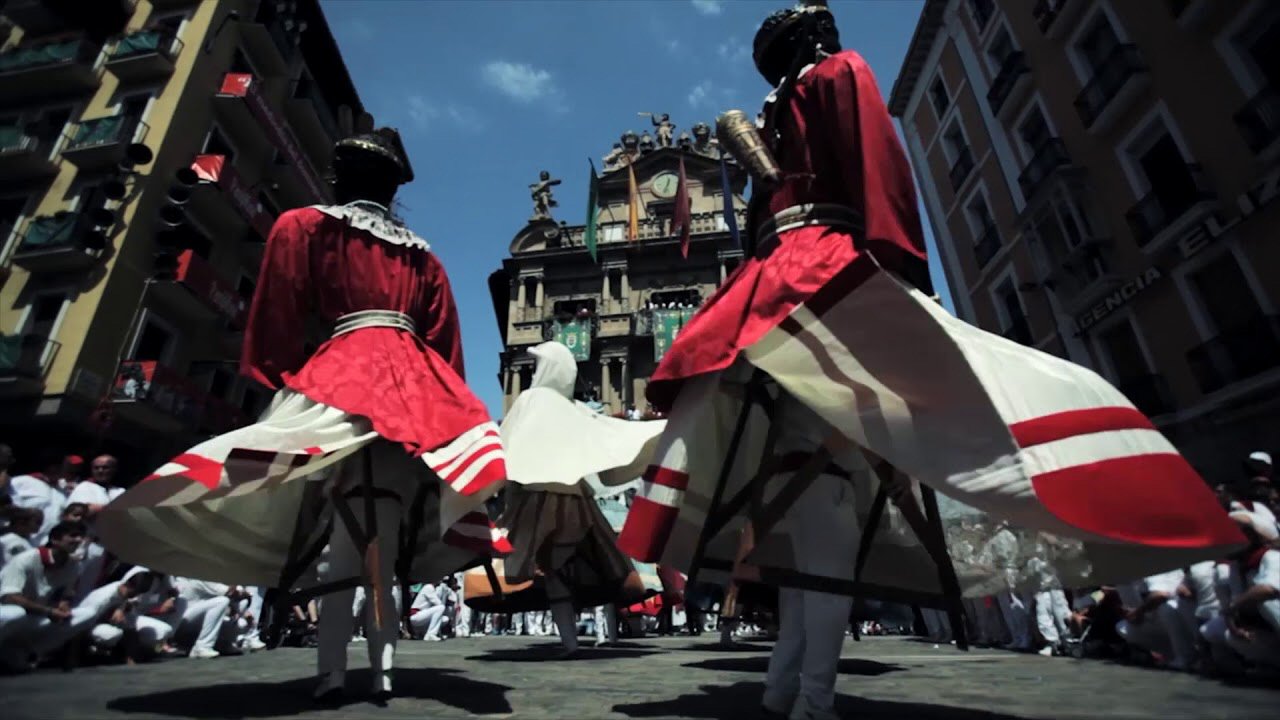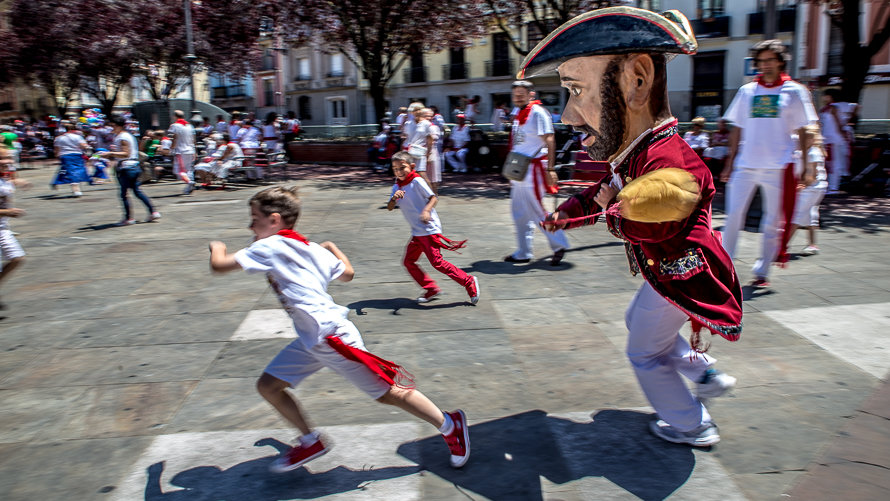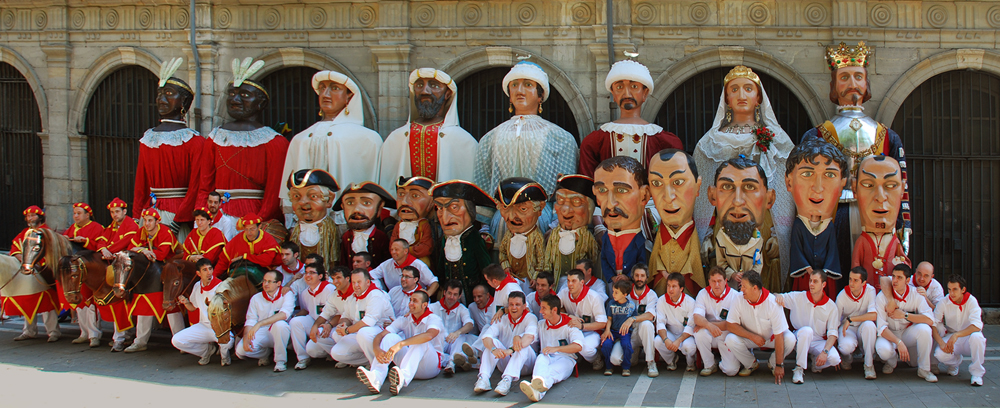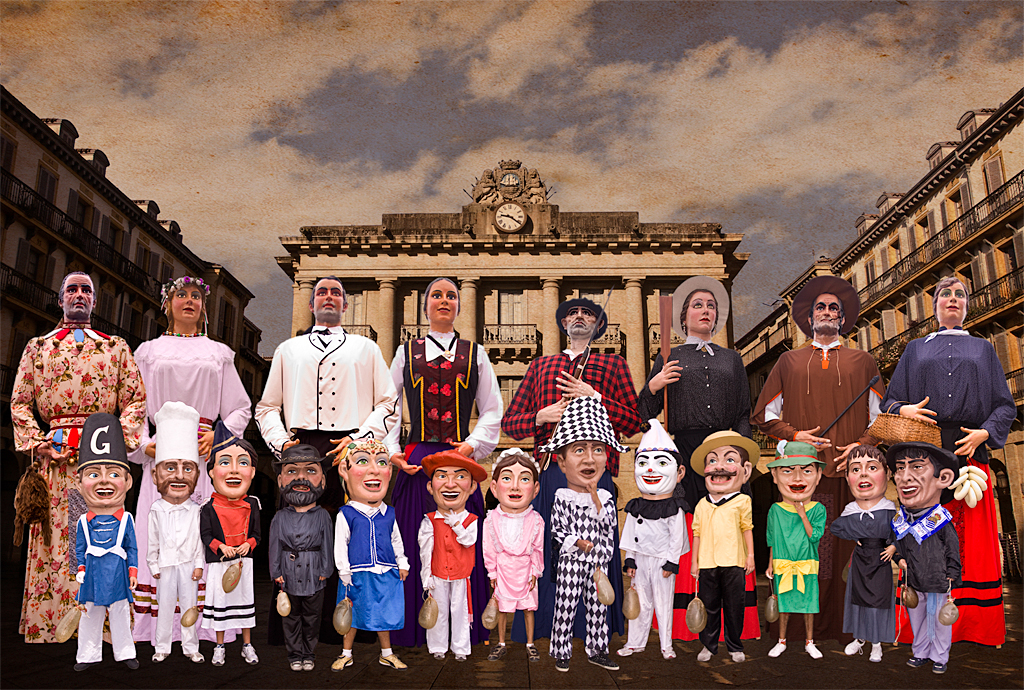In many of the pueblos of Cataluña during the middle-ages Corpus Christi was celebrated, as in the rest of Spain, with processions whose main theme was biblical, with effigies of Christ and the Virgin Mary as the highlight of the event. But unlike the rest of Spain, at some point the processions lost their religious origins and began to show other characters of a less religious nature. The first recorded appearance of a different kind of procession was in Zaragoza in the 15th century, during the reign of Alfonso V. The king is believed to have brought the idea of the gigantes and cabezudos back from Naples or Sicily where he had seen it performed whilst on a visit. The Spanish are not a people who will turn down an excuse for a fiesta, and this idea seemed much better than the serious, tragic, religious processions. The idea soon caught the imaginations of the artisans who saw the first figures, and there were plenty of volunteers to wear the costumes in the parade.

Photo: Ayunt Pamplona.
Constructed in the same proportions to normal people, but about three times bigger, the gigantes were assembled from cane and wood. Inside the framework was a saddle that sat upon the shoulders of the man inside. The head of the puppet was made form carton-pierre, a mixture of papier-mâché and plaster of Paris and painted. Finally, the whole thing was covered in a long robe or dress that hid the geganter or operator. The arms of the puppet are left to hang at the side of the figure during the procession, but when the music begins, the figures gyrate around each other and the arms fly out, giving the impression of real dancing people.
The second type of puppet, the cabezudo, is in the form of a man wearing an outsized papier-mâché head. This type of figure is much more agile and mischievous, and runs in and out of the crowds chasing young girls and children, often hitting them with an inflated bladder on a stick. They have names that reflect their defects or place in history. These puppets, originally called kilikis, (from the euskera kili-kili, meaning somebody who tickles or irritates you) were created in the 16th century and have more-or less retained their original form. Later, they became known as gigantillos, but now are called cabezudos.

Photo: Jorge Urdanoz
From left to right, this motley collection of characters go by the names of Patata, Barbas, Coletas, Caravinagre, Napoleón and Berrugón. They are the 6 regular cabezudos for the cabalgata of Pamplona. Patata is a description that speaks for itself, and Barbas and Coletas (beard and ponytail) whose origins are unknown, were created by an artisan called Tadeo Amorena sometime around 1860. The last three are the most well-known and most fearful characters. Caravinegre, (vinegar face) a miserable bad-tempered man, and Napoleón is supposedly a parody of the French Emperor, who made his brother, Joseph Bonaparte, King of Spain and gave him a puppet government to rule with. The Berrugón was once a magistrate whose facial warts gained him a place in history.

Photo: Ayunt Pamplona
It was not long before other towns and cities rallied their craftsmen to make figures for their own fiestas. Pamplona was not far behind Zaragoza, and by the 16th century, the giant figures were known to have accompanied the more traditional figures of the Corpus and the festival of Minerva. Pamplona’s city records show that for the early comparsa, the figures were burned at the end of the festival, but later records from 1657 show that money was set aside for the construction of 8 new figures by the local craftsman, Francisco de Azpillaga. These were not to be burned, but were to be used for the fiestas de San Fermín each year. The idea had caught on, and characters were added or omitted as the years went by. But for every silver lining there has to be a cloud, and the church took a dim view of the way things were going.
In 1789, by order of King Carlos III, the use of los gigantes in the processions was forbidden. The king explained that they were becoming a distraction to the real meaning of the Corpus Christi, and the figures were confiscated and stored in one of the side rooms of the cathedral. But lighter hearts must have lobbied the church, because in 1813 they were once again allowed out for the fiesta. By now, the form of the cabalgata de los gigantes had been more-or-less set, and Zaragoza city records show that there were 4 gigantes and 4 cabezudos. For the comparsa of 1841, the main four gigantes represented the four continents of the world, Asia, America, Europe and Africa. They paraded at the same time as the traditional Corpus Christi processions, and the taller figures were meant to signify the good in the world, whilst the smaller figures represented the bad people of the world. The parades were usually accompanied by brass horns or groups of musicians playing drums and chiflaina. (A kind of penny whistle.)
In 1860, Zaragoza commissioned Félix de Oroz to construct a new set of 8 gigantes which represented the different races of the world as well as famous people; A Negress and a Chinese man, the king and queen, a duke and a duchess and Don Quixote and Dulcinea. Four more cabezudos were added to the original line up, Boticario, the evil looking proprietor of a farmacia who trembles and shakes, Robaculeros who started off as Sancho Panza, but now represents a lazy slow witted character, Torero a bullfighter and the Forana the female form of Forano. The origin of the Forano is lost to time. Some sources say that he represents a coachman and another name for the puppet is el cochero, The Foranos possibly began life as parodies Joseph Bonaparte, but it is now thought that they represent foreigners of any kind.
These figures became popular, and nothing was changed until 1904 when figures of real people from Zaragoza were sometimes added to the figures in the parades. 1916 was a special year when it was decided to officially marry the Forano and Forana, and the ceremony was celebrated by the attendance of gigantes from other towns and cities in the area. In 1964, after 164 years of service, it was decided to burn the figures that Félix Oroz had created, and make a whole set of new ones. The task of making the new cabezudos was given to Modesto González Latorre, whilst the gigantes were to be made by Armando Ruiz, who was instructed to add two more gigantes, Gastón de Bearn (el Bearnés) and la Bearnesa to celebrate the unification of Bearn and Aragon. When the gigantes parade they are separated into males on one side, with the corresponding females on the other, and when the music plays, the partners dance together.

The full line up of the Cabalgata de los Gigantes in Pamplona. Photo: Jorge Urdanoz.
There are a number of cabalgatas in the cities of northern of Spain, with smaller pueblos sometimes parading their own gigantes in smaller local processions. Normally, for Zaragoza, the modern procession has 12 of the giant figures and 11of the smaller ones, although the number has varied over the history of the event. Pamplona has 8 gigantes, but 11 cabezudos.

The gigantes of Lerida. Photo : Pelip Vilardell
Lerida has 10 splendid gigantes as well as a varying number of cabezudos, and the cabalgata in San Sebastion has a totally different line up to all the others.

The gigantes of San Sebastion. Photo: Tourismo San Sebastian.
Whichever city you visit, you will be guaranteed a good and entertaining holiday if you can see the cabalgatas, but beware; the prices for accommodation, drinks and food double during the fiestas. Even then, it’s well worth the visit.